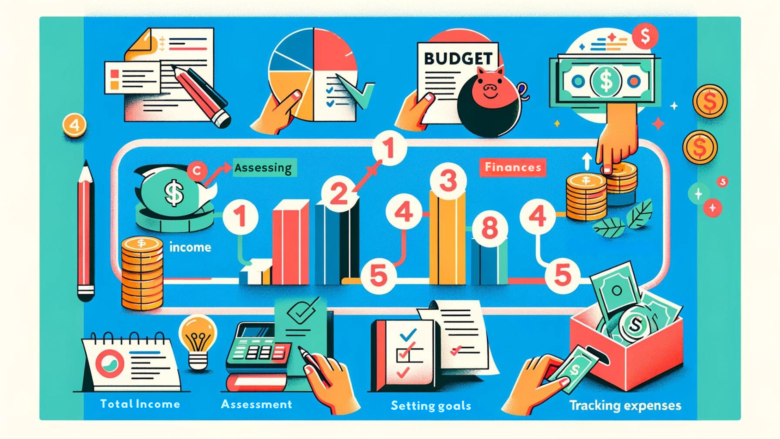Have you ever felt overwhelmed by your finances? You’re not alone! Many people struggle to manage their money effectively, but there’s a simple solution: budgeting. In this post, “Master Budgeting to Achieve Financial Stability,” we’ll explore how you can create a budget to achieve financial stability. Let’s break down the steps and tips to help you manage your money better, making your financial life a little less stressful.
Understanding the Basics of Budgeting
First things first, what exactly is budgeting? Simply put, budgeting is the process of creating a plan on how to spend your money. This plan ensures you have sufficient funds for your necessities and priorities.
Why is budgeting important? A budget can help you save money, avoid debt, and achieve your financial goals. It acts as a roadmap, guiding your spending and helping you make informed decisions about your money.
You can choose from various types of budgets. For instance, the zero-based budget allocates every dollar of your income to expenses, savings, or debt repayment. The envelope system uses cash for specific spending categories, while the 50/30/20 rule divides your income into needs, wants, and savings/debt.

Steps to Create an Effective Budget
Creating a budget might seem daunting, but it’s easier than you think. Here is a detailed guide to help you begin:
1. Assess Your Financial Situation:
-
- Income: Start by listing all your sources of income. This could include your salary, side hustle earnings, and any other money you receive.
- Expenses: Next, divide your expenses into fixed (such as rent and utilities) and variable (like groceries and entertainment). Understanding where your money goes is vital.
2. Set Financial Goals:
-
- Short-term Goals: These might include building an emergency fund or paying off a credit card.
- Long-term Goals: Think about saving for retirement, buying a house, or funding your child’s education.
3. Create the Budget:
-
- Track Your Spending: Use tools or apps to keep an eye on your spending habits. Apps like Mint (a personal finance app) or YNAB (You Need A Budget, a budgeting tool) are great for this.
- Allocate Funds: Based on your income and expenses, allocate money to different categories and ensure you’re saving for your goals.
4. Adjust and Monitor:
-
- Regular Reviews: It’s essential to review your budget monthly or quarterly to ensure it still works for you.
- Flexibility: Life changes, and so should your budget. Be flexible and adjust as needed.
Tips for Sticking to Your Budget
Sticking to a budget can be challenging, but here are some tips to help you stay on track:
- Automate Savings: Arrange automatic transfers to your savings account. This way, you’re saving without even thinking about it.
- Use Cash for Discretionary Spending: Implement the envelope system for things like dining out or entertainment. Once the cash is depleted, you stop spending.
- Avoid Impulse Purchases: Before buying something, ask yourself if you really need it. Wait 24 hours before deciding to purchase.
- Seek Accountability: Share your budget with a trusted friend or family member. Sometimes, having someone else aware of your goals can keep you motivated.
Common Budgeting Challenges and Solutions
Budgeting isn’t always smooth sailing. Here are some typical obstacles and how to address them:
- Unexpected Expenses: Life happens. Create an emergency fund to handle unexpected costs without derailing your budget.
- Irregular Income: If you’re a freelancer or have a gig job, budgeting can be tricky. Estimate your average monthly income and base your budget on that.
- Debt Management: Including debt repayment in your budget is crucial. Consider using methods like the snowball (paying off the smallest debt first) or avalanche (tackling the debt with the highest interest rate first) methods.
- Staying Motivated: Sometimes, sticking to a budget can feel restrictive. Remind yourself of your financial goals and celebrate small victories along the way.
Tools and Resources for Budgeting
To make budgeting easier, here are some tools and resources you can use:
- Budgeting Apps: Mint (a personal finance app), Walnut (a personal finance management app popular in India), and EveryDollar (a budgeting app) are excellent for tracking spending and managing budgets.
- Financial Planning Resources: Check out books, websites, and online courses to learn more about budgeting and financial planning. Noteworthy books include “The Total Money Makeover” by Dave Ramsey and “Your Money or Your Life” by Vicki Robin.
- Community Support: Join online forums or local financial literacy groups to share tips and get advice from others on the same journey.

Conclusion
Budgeting doesn’t have to be complicated or overwhelming. By understanding the basics, creating a plan, and sticking to it, you can achieve financial stability and peace of mind. Remember, it’s all about making small, consistent changes and being patient with yourself. Start your budgeting journey today and craft a financial tapestry for stability.
Author’s Note:
Budgeting has changed my life, and I hope it can change yours too. Remember, every financial journey is unique, so find what works best for you and stick with it. Happy budgeting!
G.C., Ecosociosphere contributor.




